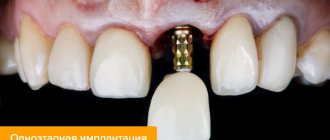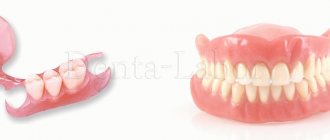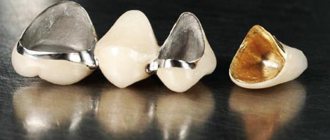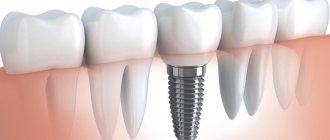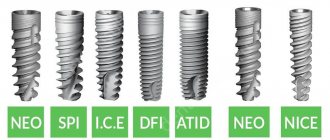Modern dental technologies make it possible to save a tooth even if it is severely damaged. For advanced caries and the complications that often accompany it, treatment is carried out in stages. First, medicine is placed into the canals, and only after some time the tooth is filled permanently. This explains why a temporary filling is placed. Depending on the clinical picture, the period of its use may vary.
Temporary filling: what is it and what is it for?
If urgent treatment is not possible, temporary filling material is placed. It does not have sufficient strength, so it is not suitable for permanent filling. But it allows you to close the tooth cavity for a certain period.
A temporary filling is placed in the treatment of pulpitis and periodontitis after cleaning the canal. It is also needed for diagnostics, when it is necessary to determine the nature of the inflammatory process and check how deep the damage is. Why is such material used for prosthetics and indirect restoration? It will protect the prepared tooth until the permanent structures are ready.
This is an excellent technique when you need to delay treatment. It also acts as a kind of insurance for the doctor, as it allows you to monitor the effect of treatment and prevent the occurrence of complications. Why do they put a temporary filling after the medicine? It will prevent the drug from seeping into the oral cavity. This method is used when devitalizing paste is applied or root canals are filled with medicinal pastes. After some time, you can clean the canal and fill the tooth.
How teeth are filled (types of filling materials).
How to fill teeth
for filling teeth in dentistry.
Composite materials are the most popular dental materials for filling teeth. The composite is a filling material consisting of an organic matrix (synthetic resin) and an inorganic filler – fine quartz powder. The size of quartz particles depends on which teeth are filled with this material. Thus, for filling materials used to restore chewing teeth, the main requirement is strength. Large quartz particles are used in such materials. The particle sizes are approximately 3.5 microns. Thanks to this, the filling is able to withstand heavy chewing loads and wear minimally over time.
Filling materials used to restore “front” teeth must satisfy high aesthetic requirements. That is, to imitate the color and transparency of the tooth being restored as much as possible and to polish it well so that the shine of the filling matches the shine of the natural tooth. Therefore, quartz particles in such materials should be very small - approximately 0.01-0.08 microns. In dentistry there is such a term - “dry shine”. It means the ability of a polished filling, dried from saliva, to imitate the shine of a living tooth. In order to “match the color” as accurately as possible when placing a filling, a set of filling material for aesthetic dental restorations consists of composites of different colors and transparency.
Fig 1. Fig 2.
Fig 1. Structure of filling material for chewing teeth.
Fig 2. Structure of filling material for anterior (frontal) teeth.
Composite materials come in chemical and light (photo- or heliocomposites) curing.
Chemically cured composites have low aesthetic qualities, but are quite durable. Working with them requires a certain skill from the doctor in order to have time to “place” the filling before the material hardens.
Chemical curing filling
Light-curing composites are easy to use and have fairly high aesthetic characteristics. Manufacturers producing filling materials provide a large selection of heliocomposites that meet the highest requirements.
Light-curing composite filling materials
Clinical examples of dental filling with heliocomposite materials
1. Replacing old silver amalgam fillings
2. Aesthetic restoration of the central upper incisors. Shows up well
dry shine of restorations.
3. Treatment of caries. A dry shine is also visible after polishing the fillings.
Dental cements were the most common filling material 15-20 years ago. Currently, glass ionomer cement is used as a filling material. It does not change its properties under the influence of oral moisture. To prepare glass ionomer cement, fluoroaluminosilicate glass powder is mixed with polyacrylic acid. After mixing the powder and liquid, a paste with a creamy consistency is obtained. In this form, the cement is introduced into the prepared cavity, where it hardens within a few minutes.
Glass ionomer cement
An important quality of glass ionomer cement is the release of fluoride throughout the life of the filling. This helps reduce the risk of caries at the filling-tooth tissue interface. As the main filling material, glass ionomer cements are used in pediatric dentistry for filling “baby” teeth.
In the treatment of caries in adults , glass ionomer cement is used as an insulating spacer under a composite filling. The advantage of glass ionomer cement is that it does not require excessive tooth moisture at the time of filling. This cement lining protects tooth tissue from chemicals used during the placement of a composite filling and promotes the regeneration of dental tissue.
Silver amalgam has lost its former popularity over the past 15 years. Before the advent of modern systems for mixing mercury and silver powder, it was necessary to have a hood in the dental office. This is due to the toxicity of mercury vapor. Considering this disadvantage of preparing silver amalgam, automatic amalgam mixers appeared.
A capsule containing mercury and silver powder, separated by a special membrane, is inserted into the amalgam mixer In the amalgam mixer, mercury and silver powder are combined and mixed under the influence of vibration. In this case, no mercury vapor is formed due to the precise dosage of the components and the tightness of the capsule. The resulting alloy (amalgam is an alloy consisting of 2 metals) is introduced into the cavity prepared in the tooth and condensed (compacted) with a special tool.
Placing a silver amalgam filling
The advantage of amalgam is the long service life of the filling, high strength, antibacterial properties, and low cost.
The disadvantages of amalgam include poor adhesion (“stickability”) to tooth tissues and the need to return to the dentist to polish the filling. Also, amalgam fillings have unsatisfactory aesthetic qualities and cause darkening of tooth tissue. The coefficient of thermal expansion of amalgam is higher than that of tooth tissue, which can cause chipping of the thin walls of a filled tooth.
Coloring tooth tissue with amalgam filling
Scientific studies have proven the toxicity of amalgam fillings. Mercury vapor released from amalgam fillings over a long period of time has a neurotoxic effect. According to studies, an amalgam filling releases from 10 to 15 mg from a surface of 0.4 cm2. mercury per day. This indicator significantly exceeds the maximum permissible standards and does not comply with SanPin and WHO standards. Scandinavian countries have introduced a complete ban on the use of amalgam in dentistry. In many countries, they have stopped teaching the use of amalgam in dental institutes, and in these countries dentists are not recommended to place amalgam fillings for pregnant women.
Types of temporary fillings
Such fillings are made from environmentally friendly materials and therefore do not have a toxic effect on the body. They are flexible, easy to install, and harden quickly. Apply evenly. The following types of temporary fillings are often used in dentistry:
- Artificial dentin. The drug consists of zinc oxide, kaolin, dehydrated zinc sulfate. The substance is paste-like, which is achieved by adding water. It hardens in just 3 minutes. Often used to determine the shade of a permanent restoration - before a crown
. - Dentin pastes. The composition
of the product is the same as the previous drug. The difference is that it is mixed with essential oils. The hardening time is longer, but its strength is also better. - Karyosan. Used for filling canals.
- Zinc-evengel cement. Suitable for cases where the dental nerve is inflamed. Used as a local anesthetic.
- Polycarboxylate cement has been used in dentistry for a long time. This material hardens quickly.
- Vinoxol. Used when long-term treatment is expected.
Such compositions differ from materials that are used for permanent fillings. In the future, they must be changed.
Filling using temporary materials
More often, such compositions are used after therapeutic and endodontic treatment. In most cases, they are preceded by x-ray diagnostics, which makes it possible to determine the type of damage and the extent of inflammation. Local anesthesia allows you to prepare, clean the carious cavity, remove the pulp and clean the canals without pain. To install a temporary filling, perform the following steps:
- treat the oral cavity with antiseptic agents;
- lay a medical pad - when required by the treatment protocol;
- filling material is placed on the tooth.
In acute periodontal disease, all actions are performed 2–3 times, so temporary compounds are used to fill the canals repeatedly. It's easy to remove them. To do this, the dentist will need a drill and hand tools.
Wearing period
By determining how long a temporary filling material is placed, we can talk about its service life and the maximum possible wear without damage to the teeth. In each case, the doctor selects the most suitable composition, which has its own strength. In addition to the properties of the material, the quality of hygiene affects the service life. But if you are interested in how long it takes to walk with such a filling, you can focus on the following data:
- 1–7 days - for pulpitis, advanced caries;
- 1–3 weeks - when eliminating inflammation in the root canals;
- up to 3 months - when you need to treat a cyst, granuloma.
Based on the clinical picture and the manipulations performed, the doctor will determine the exact period of the temporary filling.
Preparing the canal for filling
- Careful removal of tissue affected by caries. They are distinguished by their softness and color change. But, with thorough cleaning, healthy tissue is inevitably slightly affected, so more often the procedure is performed under local anesthesia.
- Pulp removal. This operation is mandatory, since it is this operation (or rather, the nerve located in it) that causes severe throbbing pain during pulpitis.
- Cleaning the root canals and determining their depth and shape.
- Mechanical treatment of root canals. It is very important that after filling the canal there is not a single piece of infected tissue left or just an empty space where bacteria will immediately begin to develop. To do this, using tools, the root canals are slightly expanded and leveled.
- Removal of microflora. To completely remove bacteria, immediately before filling, the root canals are washed with antiseptic solutions. Most often, drugs based on sodium hydrochloride and dexamethasone are used for this, and in advanced cases, metronidazole is used. It is necessary to achieve complete disinfection, so washing is carried out an unlimited number of times - as many times as necessary.
Dentistry for those who love to smile
+7
Make an appointment
What to do if a filling falls out
If the filling material falls out earlier, you should contact your doctor. In this case, there are two options for his action: either he will install a permanent filling, or he will again install a temporary one. Before visiting the doctor, you need to rinse your mouth with soda solution, mouthwash, and carefully follow the rules of hygiene.
The main thing is not to walk around with open channels, because why do they do it?
temporary fillings then? A depressurized carious cavity threatens the development of inflammation and complications.
Online consultation with a doctor about possible complications of self-medication
If your permanent or temporary filling has fallen out, or a piece of a tooth has broken off, you should not waste time or try to cover the defect yourself with something. It is best to undergo an examination and consultation with a dentist. Because no available means can replace a dental filling or perform proper sanitation. A professional assessment of the condition of the tooth is necessary. Otherwise, complications may occur, infection of the wounded area, and inflammation of the nerve. Which will lead to more complex and expensive treatment:
- treatment of pulpitis;
- restoration with inlay;
- removal of a tooth;
- dental implantation;
- prosthetics.
Rules of care
Compliance with the hygienist’s recommendations for temporary filling is one of the main conditions for effective therapy. You should brush your teeth twice a day and rinse them after eating. It is worth using a soft toothbrush. The use of whitening or abrasive toothpastes is not recommended.
Before permanent filling or restoration, it is better to avoid nuts, crackers, toffees and other products that place increased stress on such compounds. For several days after the filling is placed, it is better not to use coloring products, as they can change the color of the material. It is important to follow your doctor's recommendations. For example, during an inflammatory process, he may prescribe rinsing with antibacterial drugs.

